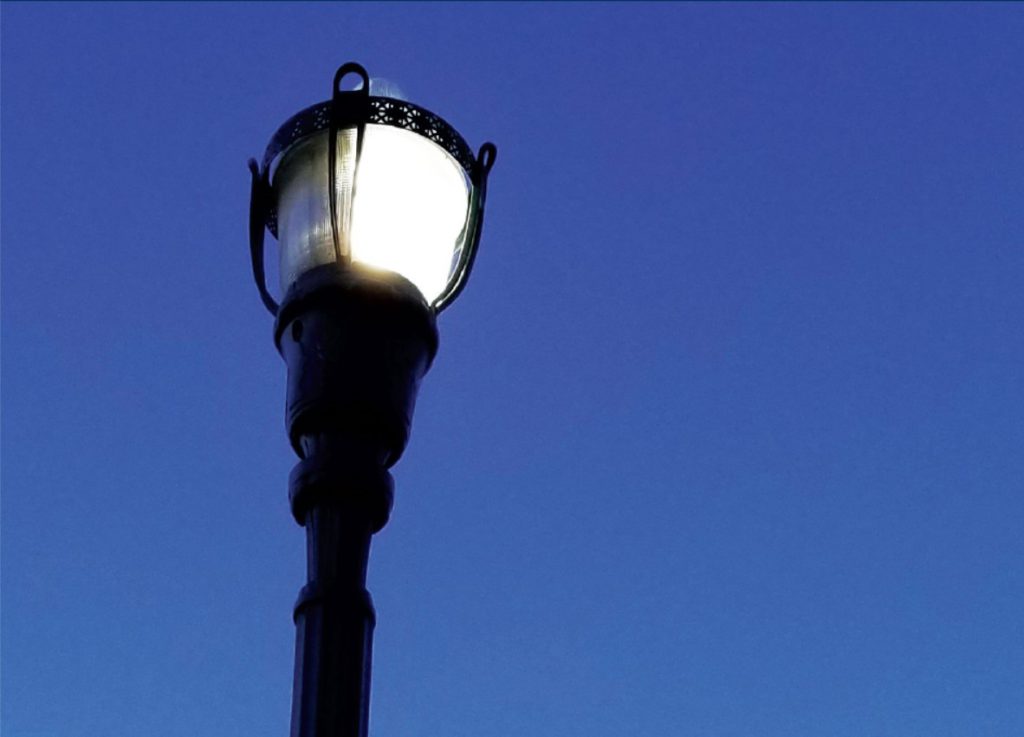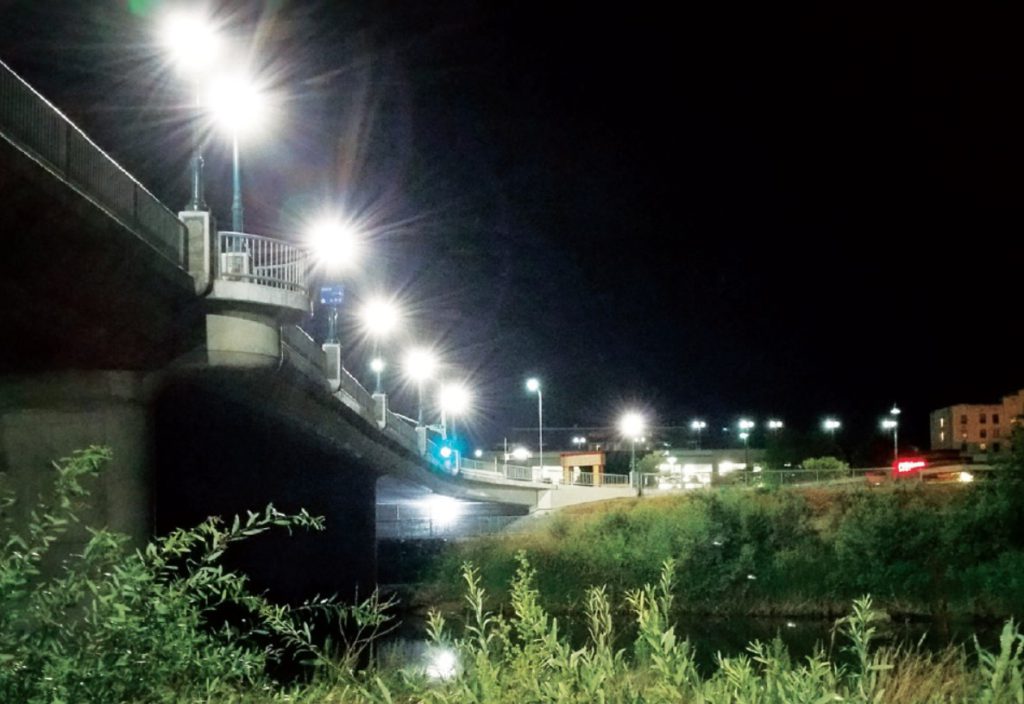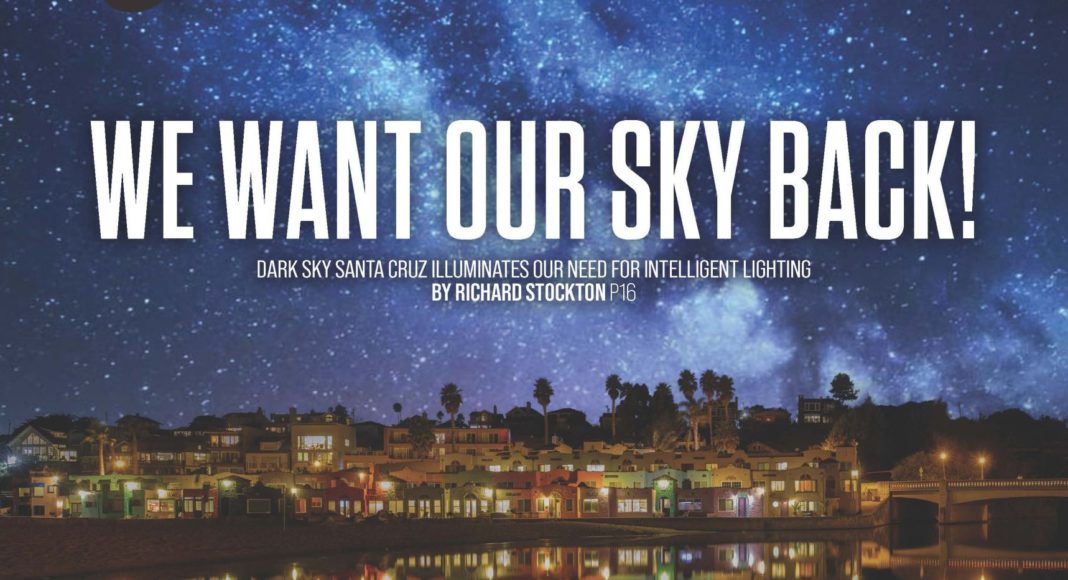When was the last time you saw the Milky Way? The last time I saw the constellation Orion, he looked like someone had stolen his sword.
The most famous Dylan Thomas poem ends with the exhortation to “rage, rage against the dying of the light.” Desmond Tutu said, “Hope is being able to see that there is light despite all of the darkness.” From Prometheus defying the gods to give us the power to light up the night, to the light in your lover’s eyes, from shedding light on a problem, to having a light bulb appear over our heads when we find a solution, we have metaphorically baked into our language the idea that light is good, darkness is bad.
Darkness is the bad guy. I’ll leave a light on for you.
But there is a growing Dark Sky movement that contends excessive light is dangerous to our ecosystem and to our own safety and health. That a group of passionate eco-nerds should coalesce here on Planet Cruz is hardly a surprise, but these scientists, environmentalists and night sky photographers are making headway with the daunting task of waking the rest of us up to our need for darkness.
Now the Dark Sky Association Santa Cruz Chapter has been tasked with coming up with light pollution guidelines for the Santa Cruz City Council to create an ordinance that will help give us our sky back and protect creatures, from zooplankton to zoo-people.
I asked Good Times Weekly editor Brad Kava why he was interested in a story about the Dark Sky movement. Brad said, “I grew up in New York. It was not until I attended a summer camp up in the Adirondack Mountains that I got to see the Milky Way. It changed my life. I was stunned that there is a universe beyond the streetlights of New York. I had never seen stars before.”
Science.org says, “Due to light pollution, the Milky Way is not visible to more than one-third of humanity, including nearly 80% of North Americans.”
I’m inclined to hear these Dark Sky people out. I feel the rhythm of day and night, sometimes daylight is so loud I need the quiet of night, but I had not even heard of these Dark Sky people one month ago.
Last week I went to the Dark Sky Santa Cruz monthly meeting on West Cliff Drive where you could actually see stars and hear waves crash on the rocks. I’m thinking when West Cliff-Dwellers invite riff-raff like me into their houses, you know there must be something afoot.
They are gentle people, the vibe around the big tables reminds me of an anti-war Quaker meeting I went to 50 years ago. Dark Sky Santa Cruz has environmental activists, lighthouse managers, astronomers, writers, scientists, philosophers; they are the nicest bunch of super-nerds I’ve ever met.
They talk to each other like scientists, they make sure every word is precisely understood. They are deep into the science and engineering of it, but before we go into the swamp to find out how our circadian rhythm evolved, here is what these Dark Sky folks want.
Principles for Responsible Outdoor Lighting:
- Useful. Use light only if it is needed. All light should have a clear purpose. Consider how the use of light will impact the area, including wildlife and their habitats.
- Targeted. Direct light so it falls only where it is needed. Use shielding and careful aiming to target the direction of the light beams so that it points downward and does not spill beyond where it is needed.
- Low level. Light should be no brighter than necessary. Use the lowest light level required. Be mindful of surface conditions, as some surfaces may reflect more light into the night sky than intended.
- Controlled. Use light only when it is needed. Use controls such as timers or motion detectors to ensure that light is available when it is needed, dimmed when possible, and turned off when not needed.
- Warm-colored. Use warmer color lights where possible. Limit the amount of shorter wavelength (blue-violet) light to the least amount needed.
But what about crime?
Santa Cruz Dark Sky activist Jeff Parry said, “Hey Richard, we are not the Dark Ground movement. We understand we need light to safely get around at night. We are advocates of intelligent lighting, lighting that illuminates what is necessary, and no more. This can be accomplished through correct shielding, lowering total lumens, and using warmer-spectrum lighting. Our goal is to help establish a new Lighting Ordinance for Santa Cruz City and Santa Cruz County.”
I’m standing in the backyard of my pal’s house in Santa Cruz. Three hundred yards behind his house there is a brilliant light towering over a shopping center that lights up the night with a halogen light, covering hundreds of houses, backyards, and streaming into bedroom windows like alien tractor beams. If I sit on his couch, the bulb shines in my face like a spotlight.
I agree with my new Dark Sky buddies, this is light trespass. It is a term to describe a form of light pollution where illumination, from a neighbor or a business or street lighting, spills onto one’s property in a way that creates a disturbance.
Just like the notion that someone’s right to swing their arms stops at your nose, their right to illuminate their property should stop at your property line.
Dark Sky Jeff Parry tells me, “All it would take to give our backyards back their darkness would be to put shields around the towering light so all its light would be directed at the shopping center parking lots and buildings. It would keep that shopping center just as safe.”
Well-lit areas can make it harder for criminals to conceal their activities, and potentially deters some types of crime like burglary or vandalism. But in some cases, increased light can aid criminals by improving their visibility. Chicago lit up their most dangerous alleyways, homicides there went up. They could see their target easier.
A 2015 study published in the Journal of Epidemiology and Community Health found that streetlights don’t prevent accidents or crime but do cost a lot of money. The researchers looked at data on road traffic collisions and crime in 62 local authorities in England and Wales and found that lighting had no effect, whether authorities had turned them off completely, dimmed them, turned them off at certain hours, or substituted low-power LED lamps.
For me, when lights are glaring bright, the glare destroys my perception of contrast, and I can’t see. I’m nearsighted and wear thick glasses, and whether I’m driving or walking, glare turns me into Mr. Magoo.
Andy Kreyche of Dark Sky Santa Cruz says, “Light seems to be the solution to anything; you got homeless people hanging around? OK, put up a light. Need safety, security? Put up a light. It’s a knee-jerk reaction, that more light is safer. Well, that’s not always the case.
If you have a bright light that causes glare and you blind people, it can make them unaware of their surroundings beyond that light. It’s the whole issue of light trespass. That’s part of the proposed ordinance, “If you have a light, keep it on your property.”

A Dark Sky Santa Cruz Win
In early 2021 a Dark Sky Santa Cruz member and customer of the US Bank on Morrissey Boulevard notified the branch manager that lighting along one side of the building could be improved. Three wall pack fixtures meant to illuminate the parking lot were so bright that their light trespassed far beyond bank property. The resulting glare was blinding to bank patrons approaching the ATM at night and distracting to drivers and shoppers of the adjacent grocery store.
The matter was referred to the property manager and replacement fixtures were selected from ones certified by IDA (International Dark Sky Association) as dark sky friendly. The photos show the reduction in glare due by use of replacement fixtures that point down and have front side glare shield. The amber color of the new fixtures minimizes the amount of blue light.
Our DNA Clocks
The first stanza of the Bible concludes, “And God said, let there be light: and there was light.” It turns out that this is just half the story, the only pictures I’ve seen of the guys who wrote that book, they were drinking and thought the world was flat.
Chinese cosmology might get us closer to the truth with the concept of Yin-Yang; describing opposite but interconnected, mutually perpetuating forces.
Vice-President of Dark Sky Santa Cruz scientist Andy Kreyche says, “The Yin-Yang dynamic of light and dark is fundamental to the creation of life, to the point that detection of light-dark-light-dark is genetically coded into every form of life from the beginning formation of blue-green algae to diurnal animals like us. Every species on this planet evolved because of these natural cycles. Interrupt them at your peril.”
Lisa Heschong is a Fellow of the Illuminating Engineering Society. Heschong’s 2022 Keynote Address for the International Dark Sky Association convention was “How Has Life On Earth Adapted to Patterns of Light?” She points out that life evolved by our planet’s given circumstances, the earth spins every 24 hours, revolves around the sun once every year with a little tilt that creates the seasons. The moon travels around the earth every 29 and 1/2 days or so, also with a slight tilt, that creates the monthly lunar rhythms, the tides and moons.
When Algae Got Smart
Lisa likens the sun’s circadian signal (recurring naturally on a 24-hour cycle) to a two-stroke engine, dark-bright-dark-bright, “It was like a big push on a swing, to keep the movement going. But now there is barely a push at all.”
Heschong explains our light-dark clocks started evolving with algae. “Algae evolved one of the earliest forms of photosynthesis, the magical process that uses the energy of sunlight to make sugar, simply out of water and carbon dioxide. At night it reverses this, gaining energy from its sugar and exhaling oxygen.
To keep track of daytime versus nighttime, the algae evolved a gene clock protein that could keep precise time inside of its cytoplasm. These tiny organisms have a visual sensor modifying their behavior by the light-dark cycle, which is really the beginning of vision. It’s in our genes.”
Research scientist Christopher Kyba says, “For nocturnal animals, the introduction of artificial light represents the most drastic change human beings have made to their environment. Predators use light to hunt, and prey species use darkness as cover. We are only beginning to learn what a drastic effect this has had on nocturnal ecology. Glare from artificial lights can impact wetland habitats, such as frogs and toads, whose nighttime croaking is part of the breeding ritual. Artificial lights disrupt this nocturnal activity, interfering with reproduction and reducing populations.”

A Dawning of Awareness
In 2022 Dark Sky Santa Cruz tried to get Public Works to cut unnecessary light hitting the San Lorenzo River from the bridges. Because of Dark Sky Santa Cruz advocacy, Santa Cruz City Public Works installed light-blocking tape on the sides of the hundred plus bridge lights that face the river. This significantly reduced the extra light intruding into the river, at the same time not diminishing public safety. Andy Kreyche explained what Dark Sky Santa Cruz did.
“In the San Lorenzo, you’ve got two endangered species that are hardly there anymore, Coho Salmon and Steelhead Trout. Salmonids are attracted to light at night. If you have these lights going into the river, like the acorn street lights did, the juvenile fish fall prey to predators and we don’t have fish in the river.
NOAA (National Oceanic and Atmospheric Administration), which is responsible for the endangered species in the river, sent an email to Public Works that said, ‘You gotta do something about this light on the river.’ Their solution was to take Gorilla tape and put it on the inside of those lights. Walking downtown at night, you can see that the lights are shielded internally on the river side.”
In response to NOAA’s request, Santa Cruz Public Works put Gorilla tape on the inside of the globes facing the San Lorenzo River.
The Milky Way Needs A Dark Sky
The Santa Cruz Chapter of the Dark Sky Association celebrates the successful dimming of unnecessarily bright and glaring external lighting from a factory on the far west side of Santa Cruz. At first, the owner of the factory ignored their pleas, but Andy Kreyche tells me, “He had put the lights up without a permit and a former member of Dark Sky Santa Cruz sent a letter to Santa Cruz City Code Compliance, and the lights were turned off and removed.”
Factory lights in west Santa Cruz before Santa Cruz City Code Enforcement got involved.
Andy says, “Too bright light wastes energy and pollutes the environment. These lights, installed in violation of city code, could be seen well over a mile away from Wilder Ranch State Park.”
So, who needs to see all of Orion’s constellation? He is the Greek legend of a great hunter, who threatened to kill every beast on earth, but a scorpion killed him, and Zeus put him and the scorpion in the sky as constellations. Are we on the same path?
If we could see Orion and Scorpio in the night sky, it might remind us that we follow that path, as Andy Kreyche says, “…at our own peril.” Dark Sky Santa Cruz, working in tandem with the International Dark Sky Association, now wrestles with its pending recommendations to the Santa Cruz City Council.
I admit that rethinking our use of artificial light has taken me awhile, but every time I have trouble driving because of glare, or sleep is interrupted because of prison-break light intensity blasting into my house, or I think about all the nocturnal critters trying to hide, or I miss seeing all of Orion, valuing darkness makes more sense to me.
I’ll leave a light off for you. ⬛














Excellent article! Wish we would utilize less light in San Luis Obispo County!
So awesome! I hope we have more ordinances in play and make Santa Cruz a dark sky community
Thanks to Richard Stockton, Good Times and Dark Sky Santa Cruz for a very important lesson to be learned by every reader!
Thank you for this “illuminating” article, Richard. You and Dark Sky have it exactly right. Sadly light pollution continues to proliferate under the false assumption that more night light is always better. Witness the Holiday Light festival where people drive through mega light structures. Las Vegas is visible from dark night sanctuaries in Utah. Migrating birds get confused from night light, and small flying insects that are food for bats are attracted to the high-intensity bulbs and die.
I have written the mayor, City Council and Public Works Director about their 20-foot high intense LED streetlights, including along the new westside trail. The lighting is unnecessary and complete overkill.
I usually receive an auto-responder email and never hear back. Once, I was referred to PG&E who wanted to charge me to replace a light outside our house with a shielded pole light that reflected more downward. I tried to pursue with their online form and calls but could not get them to respond. This is clearly a non-issue for city staff, electeds and PG&E. They also hear from uninformed home and business owners who want as much light as possible in the mistaken belief that it deters crime.
And it is the pineal that will regulate the date and the light in the wonderful scheme of your body. Give it a chance to bless you cause we need both light and dark to keep the rhythm .